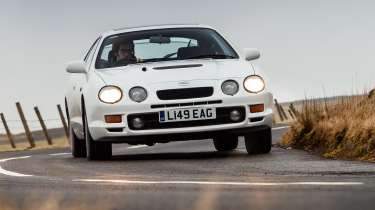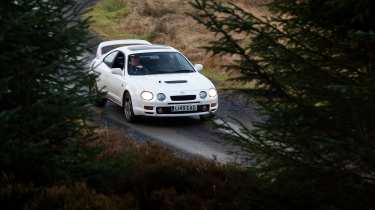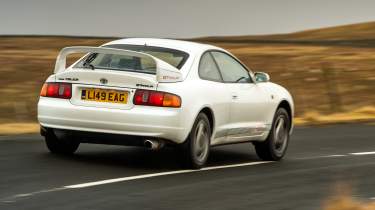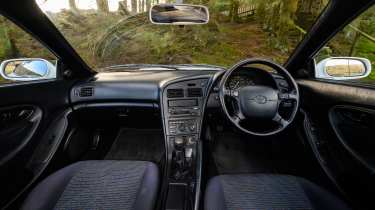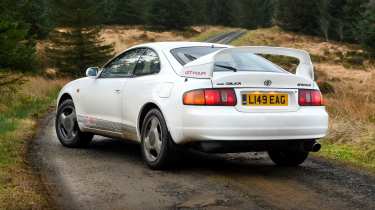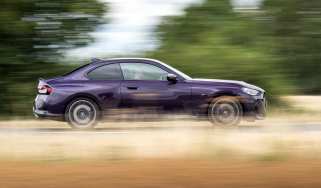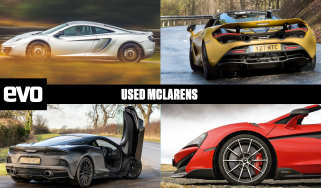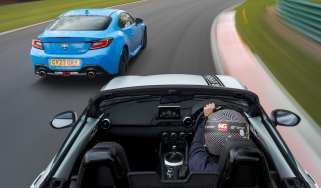Toyota Celica GT-Four (1988 - 1999) review – the forgotten Group A rally icon
The GT-Four was a staple of the World Rally Championship and won several of driver’s and manufacturer’s crowns, yet it’s a rare sight today
Homologation. The very word can send shivers down the spine of even the most jaded petrolhead and harks back to a time when the heady cocktail of motorsport DNA and series production intersected perfectly to create some of the greatest driver’s cars to grace our roads. And perhaps the finest of all date from the Group A era of rallying. Integrale, Escort RS Cosworth, Subaru Impreza and Mitsubishi Evo are all evocative names that elicit memories of flat out, foot to the floor antics in murky forest stages.
One name that’s missing from that list is the Toyota Celica GT-Four and it could be argued that it should really feature much higher up the list of Group A rally heroes than it does in most fans’ memories. Toyota’s part in the Group A era was arguably even greater than Lancia’s, as it was there all the way through. It began with a hurriedly homologated Supra that was really too heavy, but Toyota got into its stride with the first Celica GT-Four (ST165) in May 1988. It wouldn’t take its first win until a year later in Australia with Juha Kankkunen, but in 1990 Carlos Sainz won four rallies and the drivers’ title.
More reviews
Group tests
- Alpine A290 v Alpine A110 – how much DNA do they really share?
- Ariel Atom 4R v Caterham Seven ‘evo25’: power-to-weight heroes go head-to-head
- Ariel Atom 4 v Caterham Seven 310R v Lotus Elise Cup 250
- £200,000 supercar shoot-out: AMG v Aston Martin v Maserati v McLaren
- Who makes the best GT car? Aston Martin v Bentley v Maserati
- Caterham Super Seven 600 v Super Seven 2000
- Corvette Stingray v Porsche Cayman GTS v Audi R8 RWD
- Volkswagen Golf GTI Clubsport v Cupra Leon 300 – what's the best mainstream hot hatch?
- Great Ferrari hypercars driven: 288 GTO, F40, F50 and Enzo head-to-head
- GMA T.50 v McLaren F1 – has the best car in the world been dethroned by its successor?
In-depth reviews
- Abarth 600e 2025 review – Italy gives the Alpine A290 something to worry about
- Alpine A110 2025 review – an all-time great sports car living on borrowed time
- Aston Martin Vantage 2025 review – a thrilling alternative to the McLaren Artura
- Audi R8 (2015 - 2024) review – the ultimate soft-focus supercar
- BMW iX 2025 review – the ugly duckling still stomps the Tesla Model X
Long term tests
- Abarth 695C Turismo Fast Fleet test – 10,000 miles in the Italian hot hatch
- Alfa Romeo Giulia Veloce Fast Fleet test – living with the sharp Italian saloon
- Alpina B10: end of term report
- Alpina B10
- Aston Martin Vantage (2006) Fast Fleet test – living with a £30k V8 Aston
- Caterham Seven evo25 Fast Fleet test – living with a track car for the road
- Caterham Seven evo Edition revealed – bespoke 420R joins the Fast Fleet
- Cupra Leon Estate 310 4Drive Fast Fleet test – living with the 306bhp hot estate
- Ford Mustang GT
- Ford Mustang GT
Review
- New Bentley Batur 2023 review – can it possibly be worth £1.65m?
- 2023 Chevrolet Corvette C8 Z06 review – the American 911 GT3?
- BBR Supercharged Mazda MX-5 (ND) 2023 review – tuned 250bhp roadster driven
- MG4 Trophy 2023 review
Reviews
- Abarth 695 75 Anniversario edition 2024 review – a fitting send-off for Abarth’s hot supermini?
- Abarth 500e 2023 review
- AC Cobra 378 Superblower MkIV 2021 review – another V8 Cobra, but with a GM heart this time
- Acura Integra Type S 2024 review – a Honda Civic Type R with added restraint
- Alfa Romeo Giulia 2025 review – get one while you still can
- Alfa Romeo 33 Stradale 2025 review – a rare Italian jewel beyond compare
- Alfa Romeo SZ: history, review and specs of an icon
> Toyota GR Yaris 2025 review – the modern homologation special gets even better
That first Celica GT-Four (an acronym of 'Grand Touring Fulltime On-road Uniquely Responsive') was based on the fourth generation Celica, taking that car’s 2-litre four-cylinder engine, adding a turbocharger to create Japan’s most powerful 2-litre engine in its day. It was good for 185bhp and a 0-62mph of just over 8sec. It looked remarkably similar to the run of the mill Celicas but featured full-time four-wheel drive for improved handling and better traction.
Back in the forests Lancia was back on top in 1991, but 1992 saw the hugely successful Celica Turbo 4WD (ST185) launched into the WRC. Curiously the ST185 road cars had been around since 1989, but it wasn’t until 1991 that a homologation version (called the Carlos Sainz Limited Edition in Europe and the GT-Four RC in Japan) with a water-to-air intercooler, a larger turbo and new bonnet and bumpers was offered for sale. Power was up to 205bhp which equated to a 0-62mph time of 7.6 seconds and a top speed of 143mph in road trim. Of the 5000 cars needed for homologation 3000 came to Europe and of those 440 were destined for UK consumption. Anyway, the ST185 secured three straight drivers’ titles (Sainz, Kankkunen and Auriol) and two manufacturers’ championships.
The Celica GT-Four (ST205) was released in 1994 (only 2500 needed to be produced by this stage). It offered a larger rear wing, better cooling and less weight thanks to an aluminium bonnet, a water spray for the intercooler and extensive changes to the suspension, most notably the ‘Super Strut’ set up. There was also all the gubbins for the rally team to plumb-in both a water injection system and anti-lag. Power was 239bhp in European spec and 251 in Japan. Performance was improved again with 0-60mph taking 5.9sec with a top speed of 153mph. Only 300 came to Europe and at nearly £30k in the UK it was very expensive (over £3k more than an Escort Cosworth). Auriol stuck to the old ST185 car to win his ’94 title and with the rising challenge of Subaru and Mitsubishi the ST205 only won once – the 1995 Tour de Corse.
Group A was notorious for manufacturers trying to bend or simply flout the rules and along with many others Toyota was caught up in this. There was controversy from the very first rally, when Lancia’s Deltas turned up with bumpers moved forward for tyre clearance and extra holes for cooling, neither of which were features of the road car. But most of the creativity centred around engine power.
After the monstrous outputs of the Group B cars, the FIA wanted a 300bhp limit. This was hard to police and the first thing the manufacturers did was downplay outputs of the road cars that the rally cars were homologated on. In 1990 the first airflow restrictor was introduced (40mm to start with, later 38mm and then 34mm) and this is where things really got interesting. There was talk of nitrous hidden in fire extinguishers or spare tyres filled with additive and fluids running through roll-cages.
But the biggest scandal was the one that saw Toyota Team Europe (TTE) excluded from the 1995 season and banned from competing in 1996. At the Rally Catalunya in 1995 officials were tipped-off to a clever spring-loaded mounting system for the Celica’s air restrictor that allowed it to be bypassed without disturbing scrutineering tags. Max Mosley later called it ‘the most sophisticated and ingenious device I have seen in 30 years of motorsport’.
What’s we said
Celica GT-Four (ST205), evo 271 – Group A icons
‘There’s a strange aura that clings to this car. Formidable. Unsuccessful. The cheater’s car, or arguably simply the one that got caught. It was very expensive when new, sold in small numbers, and sometimes received a slightly cool response from the media. It came from a dominating family but failed to continue the victorious bloodline. It will forever be the outsider. The black sheep.
‘However, put into the context of today, and I find the Toyota beguiling. For a start, you sit obviously lower, even laid back, and the view out is more restrictive than in the other Group A cars. I’m not ashamed to admit that the look, feel and smell of the interior, plus the whine when starting off in first gear, bring a lump to my throat; they’re all identical to those of the similarly 3S-powered Mk2 MR2 Mrs Towler Snr drove when I was a teenager, and the triggered senses momentarily put me back in the passenger seat of that little red mid-engined sports car, with a badly folded tie and a sixth-form ring-binder smothered in cut-out pictures of Group A Imprezas and Cosworths under sticky-back plastic.
‘The 239bhp 3S-GTE engine snaps me back to reality. It may not be the most powerful here, but its brawny, lag-free delivery and smoothness make it arguably the most sophisticated, and it really fires the Celica forward with conviction. There’s something about the balanced, calmer, planted way the GT-Four drives that gives it a more modern feel, as does its solidity – Toyota’s build quality in this era is rightly admired for its impregnability. It’s a car that feels wider in track and longer in wheelbase than the others, and while that arguably makes it less of a thrill, and perhaps an acquired taste when new, its mix of feedback and ability strike a particularly sweet note.
‘The cloud has split and the yellow light from a dying sun streams through, coating everything in the strangest deep glow. Hacking across the broad plains in the GT-Four with five pairs of headlights shimmering in the mirror, the Toyota’s composure over the evolving crests is deeply confidence inspiring, its pace continuously impressive.’
What to pay and buying guide
The good news if you’re looking at becoming an owner of a piece of Group A rally history is that prices of Celica GT-Fours are yet to enter the stratosphere. Many of its contemporaries have garnered enthusiastic followings and prices for the rarer models are well into six figures. The most you’re likely to spend on a GT-Four is £50k, and that’s for a low-mileage, virtually perfect condition ST205 UK car. If you’re not quite so choosy and are happy with a higher mileage model that’s a good usable example then £15 to £20k should buy you a very decent Carlos Sainz with reasonable miles and a decent MOT history.
There’s plenty to look for when considering a GT-Four, not least making sure it’s a genuine GT-Four. It’s relatively easy to dress up the lesser models (less so with the ST205) to look like a GT-Four, so double check all the paperwork and that the chassis number points to it being a genuine car. Many GT-Fours that are now on the market in the UK will be imports, and while there’s nothing wrong with these cars, they might be worth slightly less as a collectible model than a genuine UK car.
Rust is going to be something to watch out for – the oldest GT-Fours are nigh-on 40 years old and the youngest will have been knocking around for over 25 years so check everything for rust. Sills, wheel arches, strut mountings and even sunroof panels can be afflicted. Check for accident damage too – these cars were bought to be driven enthusiastically so chances are they may have suffered a prang at some point. On cars with pop-up headlights check the panel gaps and that they work properly.
The 3S-GTE engine is a durable unit with an iron block and alloy head but listen for any untoward noises and obvious oil leaks and smoke when driving which could indicate a worn turbo or worse. Examples that have been tuned will be more likely to fail but having said that if the work has been done by a reputable company up to around 300bhp should be possible without putting undue strain on the internals. Cambelts need regular replacement so check if it’s been done or not and budget accordingly. It’s not a big job.
What is a big job is the clutch which ideally involves the removal of the engine. Parts aren’t expensive but labour is so ensure the pedal doesn’t bite too high and that it’s smooth in operation. Gearboxes are pretty durable although linkages can become worn. Diffs are strong but their mountings aren’t so listen for clonks from the rear end.
If you’re looking at a ST205 then make sure the front suspension is creak and knock free. Its complicated Super Strut set up is complex and has more parts than you’d usually expect to find. Listen for creaking knocking when cornering or braking. Sorting out a worn-out front suspension on an ST205 will be over four figures.
Toyota Celica GT-Four specs
| Engine | In-line 4-cyl, 1998cc, turbo |
| Power | 239bhp @ 5600rpm |
| Torque | 224lb ft @ 4000rpm |
| Weight | 1390kg |
| Power-to-weight | 175bhp/ton |
| 0-62mph | 6.3sec |
| Top speed | 152mph |
| Price when new | c£30,000 |
| Value today | £7000-10,000 |
